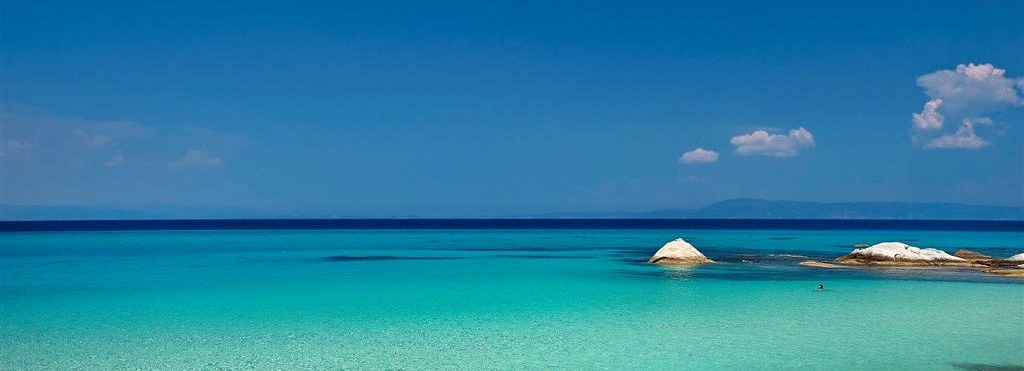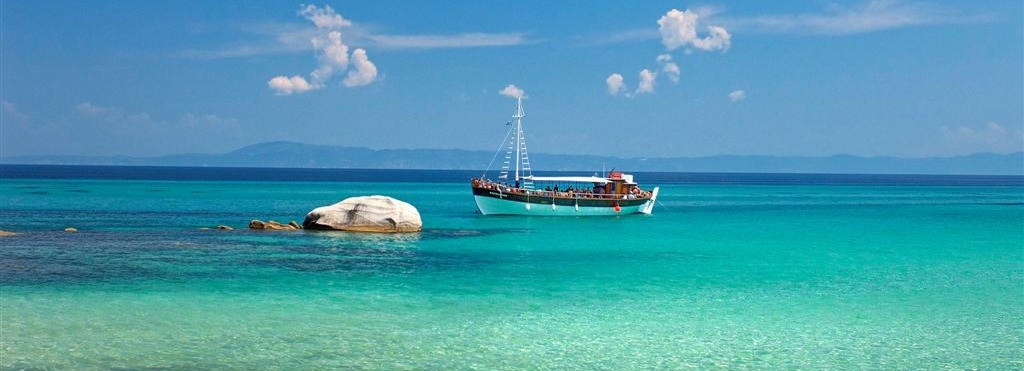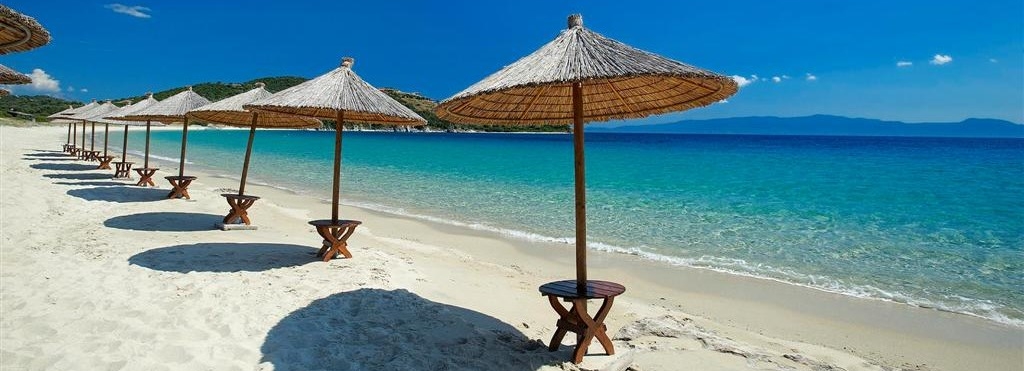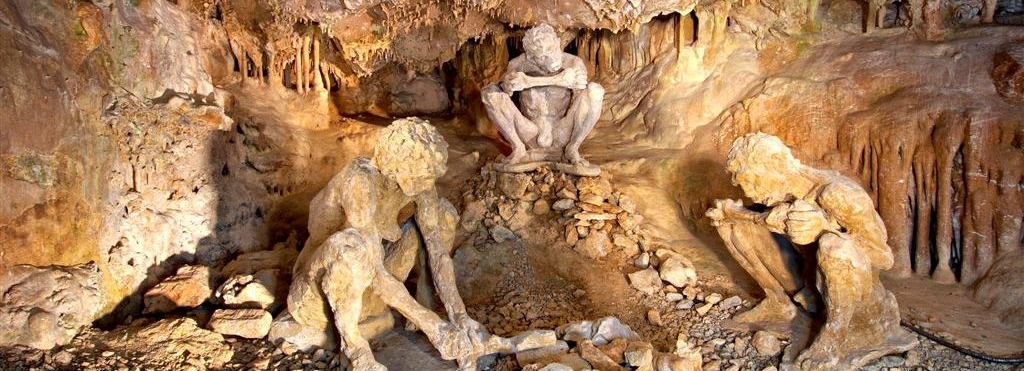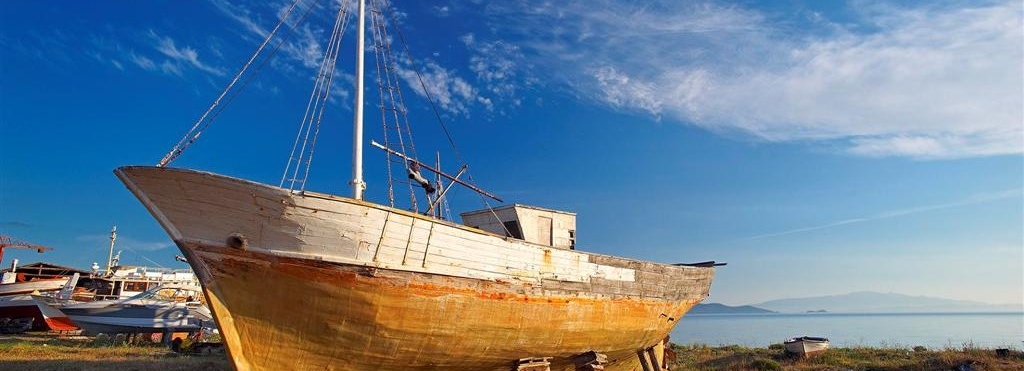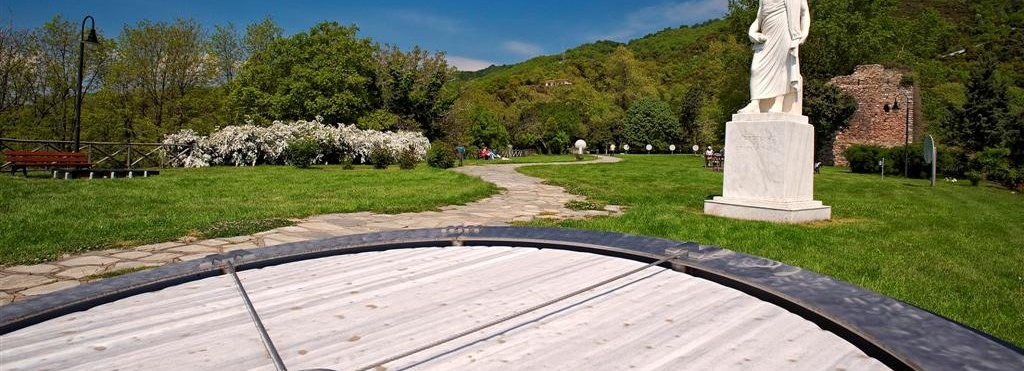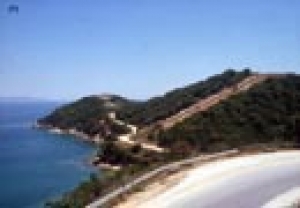Super User
Antikes Olynth
Olynth ist eine antike Polis auf der Chalkidiki, die in einer fruchtbaren Ebene im Innersten des Toronäischen Golfes in der Nähe der Ansatzstelle der Halbinsel von Pallene (heute Kassandra) in einer Entfernung von 60 Stadien (zirka 11,5 km) von Potidaia und in 4 km Entfernung vom Meer erbaut wurde.
Historische Daten
Die Örtlichkeit wurde seit der Jungsteinzeit (5300-4500 v. Chr.) besiedelt, das Wort „Olynth“ ist vorgriechisch und bedeutet wahrscheinlich „wilde Feige“. Laut der Überlieferung wurde die Stadt nach Olynthos, dem Sohn des Flussgottes Strymon, benannt. Herodot erwähnt, dass die Stadt vom thrakischen Stamm der Bottiaier, die von den Makedoniern aus Emathia vertrieben worden waren, im 7. Jh. v. Chr. erobert wurde.
Das Gebiet gehörte dann den Bottiaiern bis 479 v. Chr. In jenem Jahr schöpfte der persische Feldherr Artabazos den Verdacht, dass die Einwohner vom persischen Großkönig abfallen wollten. Artabazos ließ die Einwohner abschlachten und übergab die verlassene Stadt an die ringsum wohnenden Chalkidier.
Als Mitglied des Attischen Seebundes dürfte Olynth recht unbedeutend gewesen sein, weil sie nur 2 Talente zahlen musste, während die Nachbarstädte Skione, Mende und Torone 9, 8 bzw. 6 Talente als Beiträge bezahlten
432 wurde sie der Sitz des Chalkidischen Bundes, der auf Anregung des makedonischen Königs Perdikkas gebildet wurde. Dadurch siedelten viele Chalkidier aus den umliegenden Ortschaften nach Olynth über. Im gleichen Jahr trennte sich die Polis endgültig vom Attischen Seebund. Der spartanische Feldherr Brasidas nutzte sie als Basis für seinen Feldzug von 424.
Im 4. Jh. v. Chr. erhält Olynth als Haupt des Chalkidischen Bundes eine bedeutende politische Macht. Belege über die Aktivitäten des Chalkidischen Bundes können seit der Zeit des Nikiasfriedens (421 v. Chr.) gefunden werden, als sich die Chalkidier gemeinsam diplomatisch bewegten und dem Argivischen Bund anschlossen. Es wurden Münzen des Chalkidischen Bundes gefunden, die mit Sicherheit in das Jahr 405 v. Chr. datieren. Der Bund wurde also zweifellos vor Ende des 5. Jh. v. Chr. gegründet, und der Anlass dafür war der Selbstschutz vor einem eventuellen athenischen Angriff.
Nach Ende des Peloponnesischen Krieges entfaltete sich der Bund schnell. Gegen 390 v. Chr. sehen wir die Chalkidier einen bedeutenden Vertrag mit Amyntas, dem König von Makedonien, abschließen, und bis 382 v. Chr. waren viele griechische Städte westlich des Strymon aufgenommen worden, darunter sogar Pella.
In jenem Jahr (382 v. Chr.) gab Sparta den Bitten der Städte Akanthos und Apollonia nach, welche fürchteten, von den Chalkidiern eingenommen zu werden, und führte einen Feldzug gegen Olynth. Nach einem dreijährigen Krieg ohne Sieger stimmten die Chalkidier zu, den Bund aufzulösen (379). Diese „Auflösung“ geschah nur auf dem Papier, denn schon zwei Jahre später finden wir den Bund unter den Mitgliedern des 2. Attischen Seebundes (378-7). Zweiundzwanzig Jahre später, als König Philipp II. über Makedonien herrschte, nannte Demosthenes Olynth stärker als in der Zeit vor dem spartanischen Feldzug. Es wird allgemein angenommen, dass die Stadt zur ersten Größenklasse gehörte, und der Bund umfasste damals 32 Poleis.
Im Krieg, der 357-55 zwischen Athen und seinen Verbündeten ausbrach, war Olynth zuerst mit Philipp verbündet. Später fühlten sich die Chalkidier von der Machtvergrößerung Philipps beunruhigt und schlossen ein Bündnis mit Athen. Aber trotz der Bemühungen Athens und insbesondere des Demosthenes wurde die Stadt 348 v. Chr. von Philipp erobert, der sie dem Erdboden gleich machte.
Archäologische Daten
Die Stadt der klassischen Epoche war nach dem hippodamischen System auf einer Fläche von 600 x 300 m in Baublöcken errichtet, die durch horizontale und vertikale Straßen voneinander getrennt waren. Bemerkenswert ist, dass das Theater der Polis noch nicht gefunden werden konnte. Die Häuser besaßen zwei Geschosse mit einem Innenhof. Im Süden befand sich die Agora, und im Osten die Villen der Reichen. Zu den bereits ausgegrabenen Villen gehören jene der Agathe Tyche, des Schauspielers und der Zwillingseroten. In ihnen wurden Mosaikfußböden, Gefäße, Schmuck und Terrakottafiguren gefunden. Die ersten archäologischen Funde erblickten 1928 das Tageslicht. Die jüngsten Ausgrabungen fanden in den 90ziger Jahren statt.
Archäologisches Museum von OlynthIn
der archäologischen Stätte des antiken Olynth wird seit 1998 ein Archäologisches Museum betrieben. Ziel des Museums ist es, dem Besucher ein umfassendes Bild von der Geschichte der antiken Stadt zu geben sowie die Ausgrabungen und Restaurationsarbeiten zu beschreiben. All dies erfolgt ausschließlich mit audiovisuellen Mitteln.
Klostergut Flogita
Das Klostergut von Flogita lässt sich bis auf 1311 zurückdatieren. Bis 1924 war es ein Gut des russischen Klosters, danach ein Außenposten des amerikanischen Roten Kreuzes, wo die Flüchtlinge von Kalamaria versorgt wurden. Während der Besatzungszeit (1944) wurde es von den bulgarischen Eroberern bombardiert. Mitte der 60ziger Jahre zerstörte ein großes Feuer das Gebäude, das danach verfiel. Auf Beschluss des Stadtrates von Moudania wurde das Gelände 1999 an die 10. Behörde für Byzantinische Altertümer abgetreten, damit die erforderlichen Restaurierungsarbeiten durchgeführt werden können, um dort das Zentrum für Byzantinische Kultur der Chalkidiki „Justinian“ unterzubringen, wie es vom Archäologenteam genannt wurde, das für die Arbeiten verantwortlich ist. In diesem Gebäude wird später das Museum des Klosterguts eingerichtet. Das Projekt wird von der EU und mit griechischen Mitteln finanziert, das Budget ist auf 10 Millionen Euro veranschlagt.
Aristotle
Aristotle was born in Stageira in 384BC. His father was Nicomachus, personal physician to king Amyntas II of Macedon. His mother was Phaestis. His parents died when Aristotle was very young and Proxenos, a relative living in Atarnea, a city in Mysia, took him in his custody. When Aristotle turned 18, he left Stageira for Athens, where he studied in Plato’s Academy for 20 years, until, that is, the death of Plato in 347BC. Just prior to this Aristotle had founded a school at Assos in Troas, as a chapter of the Academy. It was then that he married Pythias from Atarneas. He stayed in Troas for three years and then crossed to the island of Lesvos, where he befriended Theophrastus, whom he later left as successor at the school of Athena. He stayed in Lesvos for two more years, namely until 343BC, when he was invited to Pella by king Philip II, to become the tutor to the king’s son, Alexander. Alexander’s education lasted for three years, until 340BC. Aristotle then retired to Stageira, where he married again, this time to Herpyllis, also from Stageira. He returned to Athens in 335BC and founded his own school, the Lyceum, later renamed to Peripatos. He directed this school for 12 years and it is in this interval that he composed all of his marvelous works. After the death of Alexander the Great, he was accused by his enemies for “irreverence” and took refuge in Halkida, where he had an estate, inheritance from his mother. It was in Halkida and at the age of 63 that he died, in 322BC. He was survived by his two children, Pythiada and Nicomachus. According to a posterior written tradition, a year after Aristotle’s death in Halkida, the people of Stageira officially moved and buried his remains in their city. It is reported that a majestic ceremony took place and a great shrine was founded at the philosopher’s tomb, while an annual festival, “Aristoteleia”, was established to honor the great man. There are present-day efforts for a revival of this great festival and the first artistic happenings took place in the summer of 1996 and were considered a great success.
Höhle von Petralona
Die Höhle von Petralona befindet sich zirka 1 km vom Dorf Petralona entfernt. Sie ist seit 1979 für Besichtigungen geöffnet. In dieser Höhle entdeckte der international anerkannte Paläontologe Dr. Aris Poulianos Siedlungsspuren von Urmenschen von vor etwa 700.000 Jahren. Es handelt sich um die ältesten europäischen Vorfahren, die bis jetzt gefunden worden sind.
Die Höhle wurde bereits seit 1960 für ihre paläontologischen und paläoanthropologischen Funde bekannt, nachdem der Einwohner von Petralona Ch. Sarigiannidis zufällig den berühmten fossilen Menschenschädel in ihr entdeckt hatte. Die Bedeutung des Fundes und seine Einmaligkeit waren Anlass für eine Reihe von Arbeiten in der Höhle und davor. 1968 und im Zeitraum 1974-1988 wurden Ausgrabungen in der Höhle durch den Paläoanthropologen Aris Poulianos durchgeführt.
In seinen Veröffentlichungen über die Höhle spricht Poulianos von Stein- und Knochenwerkzeugen, aber der vorläufige Charakter der Veröffentlichungen liefert uns kein klares Bild von ihnen. Die Funde sind auf jeden Fall höchst bedeutsam und stellen die ersten Zeugnisse für eine Besiedelung des geografischen Raums von Griechenland dar.
Aus anthropologischer Sicht ist der fossile Schädel ein sehr wichtiges Fundstück, aber die Wissenschaftler stimmen nicht bei seiner Datierung überein, und was noch schlimmer ist, bei seiner Bewertung. Die vorherrschenden Meinungen weichen stark voneinander ab, die eine hält den Schädel für den eines Menschen, der vor etwa 700.000 Jahren lebte, und die andere gibt ihm ein Alter von 200.000 Jahren.
Ancient Stagira
Ancient Stagira, homeland of Aristotle, the greatest philosopher of antiquity, teacher of Alexander the Great, are located roughly 500 meters to the southeast from the village Olympiada, above a small, mountainous peninsula, which is called “Liotopi”. Founded by colonists from Andros around 655BC on the eastern neck of Halkidiki, they were soon reached by colonists from Chalcis. Ancient sources offer us with an accurate reference for the location of the city: they place Stagira south of Akanthos and on a coastal place and add the existence of a small isled opposite the city, called “Kapros” [the same name was also attributed to the port of the city and many of the coins of the city had a wild boar (=kapros in Greek) as a symbol]. Tradition holds it that the people of Stagira moved and buried Aristotle’s relics in their city and honor his memory with a great festival “Aristoteleia”. After the Persian wars Stagira participated in the First Delian League contributing to the common fund a relatively small tax. However during the Peloponnesian War the city defected from the Athenians in 424BC and allied with the Spartans, surrendering to Brasidas. This enraged the Athenians who send Cleon to restore the city to the Athenian sphere of influence. However the Stagireans were successful in fending off Cleon and the city maintained its independence. Later Stagira was incorporated to the Chalkidian League, the federation of cities in Chalkidiki with Olyntus as its capital. In the Olynthian War (349BC) Stagira were besieged by Philipp II and destroyed, but were rebuilt by him being the birthplace of Aristotle (Herodotus, 7,115. Thucydides 4,88,2. Stabo 7,331. Plutarch, Alexander 7,3). Despite the city’s reconstruction, its destruction by Philipp was the beginning of its decline.
Antikes Torone
Nach der Mythologie war Torone die Gattin des Proteas, des Sohnes von Poseidon. Spuren von vorgeschichtlichen Siedlungen aus dem 3. Jahrtausend v. Chr. und viele andere Überreste von antiken Tempeln, frühchristlichen und byzantinischen Kirchen, Burgen usw. bezeugen, dass die Region seit der neolithischen Zeit ständig besiedelt ist.
Das antike Torone wurde von Siedlern aus Chalkis im 8. Jh. v. Chr. gegründet. Im 5. Jh. v. Chr. gehörte Torone zu den bedeutendsten Städten der Chalkidiki. Sie prägte ihre eigenen Münzen und war Mitglied des Attischen Seebundes. Thukydides berichtet, dass sie 423 v. Chr. vom Spartaner Brasidas eingenommen wurde. 348 v. Chr. fiel die Stadt an das Königreich von Philipp II. 168 v. Chr. wurde sie von den Römern erobert, und die Stadt verfiel. In byzantinischer Zeit war das Gebiet Klostergut von mehreren Klöstern des Athos.
Ihre starken Mauern und andere Gebäude wurden im 19. Jh. zerstört, als die Türken die Granitsteine verwendeten, mit denen sie errichtet waren, um Hauptstraßen in Istanbul und Thessaloniki zu pflastern. Laut den neuesten Ergebnissen der Ausgrabungen wurde festgestellt, dass das Gebiet kontinuierlich seit Ende der neolithischen Zeit bis zur Türkenherrschaft besiedelt war. Es wurden Gebäudeüberreste gefunden, aber sie sind nur sehr fragmentarisch erhalten, weil sie durch die ständige Landnutzung zerstört worden sind. Die Ausgräber widmeten der Nekropole der eisenzeitlichen Siedlung besondere Aufmerksamkeit, deren Bestehen den Zeitraum vom Ende des 12. Jh. bis Mitte des 9. Jh. v. Chr. umfasst. In dieser Nekropole wurden 134 Gräber ausgegraben, von denen 118 Feuerbestattungen und 16 einfache Erdbestattungen waren. 500 Gefäße kamen so ans Tageslicht, die entweder als Urnen oder als Grabbeigaben für die Toten verwendet worden waren.
Folklore Museum Akti Elias
Folklore Museum Akti Elias
Nikiti Hotel ATHENA PALLAS
P.C. 63088
ΤEL.: 23750 81410
Folklore Museum N. Triglia
Folklore Museum N. Triglia
N. Triglia
P.C. 63200
ΤEL.: 23730 51205
Folklore Museum Afytos
Folklore Museum Afytos
Áfitos
P.C. 63077
ΤEL.: 23740 91239
Folklore Museum Arnaia
Folklore Museum Arnaia
Arnea
P.C. 63074
ΤEL.: 23720 22323
